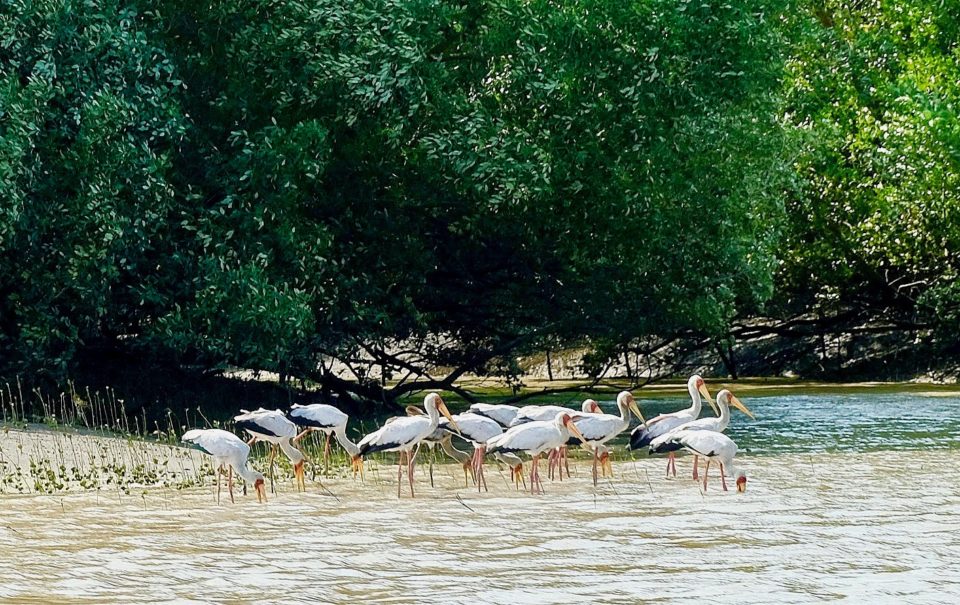FEATURE MAP’s Community Based Ecological Mangrove Restoration in Rufiji Delta

MYANMAR – The hugely important Rufiji Delta has the largest expanse of mangrove forest in East Africa but are being heavily degraded from agriculture development and deforestation. These workshops found sustainable conservation solutions and scenarios for the declining coastal forests with local communities. Mangrove restoration is not just planting one or two mangrove species in straight lines – it’s much more complex than that. To demystify this, Mangrove Action Project (MAP) and Wetlands International Africa (WI) undertook a Community-Based Ecological Mangrove Restoration (CBEMR) training for 28 participants in Kibiti, Rufiji Delta, Tanzania. All too frequently, restoration projects move straight into building a mangrove nursery and planting before understanding the issues related to the project site. These projects often fail. CBEMR supports a holistic, science-based approach that encourages practitioners to mitigate mangrove stressors and facilitate natural mangrove regeneration. This is achieved by working with the local communities to understand all social and technical challenges affecting the restoration site, including site hydrology, soil elevation relative to sea level, pressures on the mangroves and why a site is not naturally regenerating. CBEMR avoids the costs and necessity of building a nursery and planting, as natural regeneration encourages all the species in the locality to find their appropriate sites. CBEMR is an adaptable process, allowing mangrove workers to take on all sorts of different challenges, such as very high salinity in the Saloum Delta, Senegal; grazing pressure in Rakhine State, Myanmar; or encroachment for rice farming within the Rufiji Delta. READ MORE AMERICAS
Mangrove Training for the Guianas, in Coronie, Suriname

REPUBLIC OF SURINAME – Popped over to Suriname, NE South America, on behalf of Mangrove Action Project to help WWF run some mangrove training for the Guianas. First stop, Eco Resort Inn, Paramaribo. Then NW along the coast to the training venue in Totness, Coronie region. First event was the 'Marvellous Mangroves' programme, run by the irrepressible Martin Keeley (MAP), a kids education programme. This group were some excellent students from the university in Suriname. Lots of activities, ecology, talks and a visit to the Coronie mangrove education centre including an interesting exercise at the start of a field trip where the students had to close their eyes and tune-in to (and draw) the soundscape of the coast. Lots of challenges along this coast, including impounding of water by dyke building which killed off mangroves, goats and epic erosion. READ MORE
AFRICA
Earth observation data offers hope for Africa's wetlands

AFRICAN CONTINENT – Wetlands support millions of people around Africa. They include all areas that are permanently or frequently covered by water, and could be at the edge of a lake or the mouth of a river. Wetlands offer a source of freshwater, fisheries, moist soil for farming and wild plants for food, construction and medicinal uses. They also help to control floods, maintain rivers in dry seasons, recharge groundwater and purify water. But despite their importance, they remain among the most threatened ecosystems in the world. Between 1970 and 2015, inland and coastal wetlands both declined by about 35% globally. Thats three times the rate of global forest loss. This is a huge loss to important flora and fauna and a critical loss to the many people who relied on them for their livelihoods. In Africa, three things contribute to the decline of wetlands: growing populations, economic development and climate change. READ MORE
Mangrove forests trap floating litter

SAUDI ARABIA – Mangrove forests on the coasts of Saudi Arabia act as litter traps, accumulating plastic debris from the marine environment, according to new research from KAUST. The study offers an explanation for the fate of missing marine plastic litter and highlights the threat it poses to coastal ecosystems. "Of all the plastic discarded in the marine environment globally, only 1 percent is found floating in surface waters. That means that 99 percent of the plastic is elsewhere, but yet we don't know where exactly," says Cecilia Martin of KAUST's Red Sea Research Center. In previous work, Martin and others in Carlos Duarte's research group, found relatively low levels of plastic litter in the Red Sea. Next, to identify the location of this missing litter, the team used an unmanned aerial vehicle to scour the beaches. The team's analysis showed that the density of debris depends on the distance to major maritime traffic routes rather than land-based factors, such as the distance to the nearest city. Traffic further from the coast caused less litter accumulation, but only up to a certain distance. Unexpectedly, litter density began to increase again once the traffic was more than 15km away, which the researchers propose is due to currents transporting the litter to mangroves. READ MORE
ASIA
Harvesting honey saves forests and lives

THAILAND – The coastal villages of SW Thailand were once home to thriving mangrove forest ecosystems that preserved the shoreline, sequestered carbon, sheltered fish, and sustained communities that relied on small-scale inshore fishing. Today, these communities are among the poorest in the region as mangroves are lost to aquaculture, logging, and urban expansion. MAP will help 4 communities develop sustainable sources of mangrove-based income through harvesting high-quality honey from mangrove flowers. Coastal villages on the Andaman Sea in Southern Thailand are feeling the impacts of climate change, coastal deforestation and over-fishing. At least half of all mangrove forests in Thailand have been destroyed, and this has led to poverty, land degradation, loss of resource-based livelihoods, and deterioration of subsistence fisheries. This project will affect more than 300 coastal villagers working to reclaim local resources and livelihoods that will allow them to restore their mangroves. Since 2014, MAP has been collaborating with Ban Nai Nang to generate new income while restoring their mangrove forests. Today 45 beekeeping families, who would normally depend on small-scale fishing, are empowered, producing +300kg of honey per year and value-added products such as hand soaps, shampoos and balms. They want to pass on their expertise to 4 other communities, creating a sustainable network to share skills and knowledge. READ MORE
On Java’s Coast, a Natural Approach to Holding Back the Waters

INDONESIA – In the meeting hall, village leaders discussed the plight of their community and remembered the old days, before the water came. The village of 3,500 people had been on a prosperous, rice-growing river delta, famous for its fertile soils and protected from the ocean by a wide belt of mangroves. “I grew up in the 1960s when the sea was more than a mile away,” said Slamet, a fisherman. “Then the flooding began.” Beside him, the community activist Mat Sairi admitted that the village had made mistakes back then. Like almost every other coastal community in the area, they had wanted to make money by raising prawns and milkfish. So they converted their rice fields into ponds and began cutting down the mangroves along the shore to make more. “Our parents warned us that we should protect the mangroves,” he remembered. “They said the mangroves provided many benefits, like the oysters, crabs, and fish among their roots, as well as protection of the coastline. But our people wanted to make money and feed their families.” READ MORE
The Bridge Between Land and Sea

SRI LANKA – Sri Lanka is establishing itself as a world leader in mangrove restoration. Around two thirds of Sri Lanka’s population live in coastal areas, and many communities depend on mangroves for their livelihoods. Vositha Wijenayake, executive director of SLYCAN Trust, puts it like this: “Mangroves provide various ecosystem services to local communities and are often essential for their livelihoods by providing resources and fishing grounds. They are also critical component of ecosystem-based adaptation in the coastal areas of Sri Lanka, to build resilience to climate risks and impacts.” Over the last century, and especially the last few decades, enormous areas of Sri Lanka’s mangrove forests have been destroyed in state-sanctioned enterprises: to make room for shrimp farms, construction of roads, salterns, factories, tourist attractions, and expanding human settlements. Industrial pollution, resource extraction, and the country’s 26-year civil war have taken a toll as well. READ MORE Bangladesh’s Tigers Bounce Back After a Poaching Crackdown

BANGLADESH – DEEP IN THE SUNDARBANS IN southwestern Bangladesh, one of the world’s largest mangrove forests saw its tigers disappear at an alarming rate. The population of big cats had begun to disappear at the turn of the 21st century, snatched by poachers and pirates who snuck their way into the wildlife sanctuary in search of tiger skin. But a recent effort to double down on illegal poaching has allowed the population of Bengal tigers in the Sundarbans to increase for the first time in 15 years, according to a new tiger census released on May 21, 2019, the Dhaka Tribune reports. Split between Bangladesh and India, the Sundarbans mangroves spread their roots throughout 4,000 square miles in the Bay of Bengal, according to National Geographic. It is the largest mangrove forest in the world, and the only one occupied by tigers. In its prime, the forest was a labyrinthine, waterlogged jungle, almost impenetrable to humans—in other words, the perfect place to be an endangered animal. READ MORE
‘Tiger widows’ struggling to survive defy stigma

BANGLADESH – Sundarbans, a lush green UN world heritage site spread over 7,700 square miles of mostly swamp between Bangladesh and India, every villager who is a honey collector or fisherman has a tragic tiger story to share. Cyclone, heavy rainfall, and the tidal wave hits almost every year and affects the people, damages their houses and crops, increase their sufferings which make them poor/ultra-poor. According to a local development organisation, nearly 1,500 “tiger-widows” are now living in the areas close to the Sundarbans fighting against poverty, climatic disaster risks and social stigma. Our visit, We also found many women who lost their husband by tiger attacks and battling to survive defy stigma like ‘Tiger Widows’ of Sundarbans in Bangladesh. READ MORE
PWD puts up railings at Vashi to stop debris dumping around mangroves

INDIA – The state public works department (PWD) has started erecting iron railings along the Sion-Panvel highway at Vashi to protect mangroves from damage caused by the widening of the road. On April 14, HT had reported about the lack of precautionary measures taken to protect these mangrove trees as soil and debris were dumped on the mangrove area, affecting the greenery. Prakash Chaudhary, range forest officer of Navi Mumbai mangrove cell, said, “We had also written to the PWD complaining about violations made by their people in March. We are glad they are doing something about it now.” A PWD official on Wednesday said the move to put up the railings was taken after the matter was brought to their notice. “The work was started last week and will be finished by this weekend. We are covering an area of three kilometres, starting from the Vashi toll naka,” he said. “We have instructed our labourers to put the soil in such a way it doesn’t cross the railings.” READ MORE
EUROPE
Islands of nature in a sea of decline – indigenous contributions key to saving the world’s nature

FRANCE – Nature is decreasing worldwide at an alarming rate – it is time to look to indigenous peoples to help find the solution. This was one of the key conclusions reached in the first global assessment of nature and biodiversity, released in Paris. "We are at a historical crossroads for humanity,” said Cristiana Paşca Palmer, UN Assistant Secretary-General and Executive Secretary of the UN Biodiversity Convention, speaking in Paris this week at the closing of the IPBES 7 plenary session. In the largest and most comprehensive attempt to assess the state of our living planet, governments, scientists, civil society and indigenous peoples and local communities came together at IPBES7 and agreed that we are exploiting nature faster than it can renew itself. “This report shows that our global home is under threat, and nature is in decline,” said Aroha Te Pareake Mead, who attended IPBES 7 as a member of the International Indigenous Forum on Biodiversity and Ecosystem Services (IIFBES). “This decline is driven by a predominant economic and political system that favours increasing consumption and growth over living in harmony with nature,” she added. “If we can adopt a global political model that focuses on the concept of kaitiakitanga (guardianship) we might still have a chance to save our planet and all of its biodiversity” said Te Pareake Mead. Traditional knowledge is key in understanding nature. READ MORE | UPCOMING EVENTS
World Environment Day – June 5, 2019 2019 Environmental Science and Climate Change Conference September 10-11, 2019
 REGISTER NOW REGISTER NOW ACTION ALERTS Tell HSBC: Stop Profiting From Destruction – Sign the petition Halt further destruction of primary mangrove forests in the Maldives. We are urging you to write letters to the recently elected president of the Maldives and his environmental minister View Sample letter Save Pulau Kukup National Park – second largest mangrove island in the world. Sign The Petition 
Restoring The Natural Mangrove Forest
Watch movie 
Community Based Ecological Mangrove Restoration in Rufiji Delta VIEW VIDEO Video: Mangroves for the Future – A look bacK. As the latest phase of Mangroves for the Future (MFF) draws to a close, this video highlights some of the project’s most successful initiatives – from local women supporting national park management in Viet Nam to an island in the Maldives that has become a model for waste management, and everything in between. View Here Making the case for Emergency Climate Change Action

Counting Mangroves

Placencia mangrove workshop teacher's poem Volunteer with MAP – LEARN MORE Watch Children's Mangrove Art Calendar Promo 2019 Click Here  
MAP 2019 Children’s Calendar CLICK HERE You can help ensure that the knowledge and skills needed to conserve and restore mangroves is preserved in coastal communities READ MORE WANT TO GET INVOLVED?
Follow and Join MAP!    


VOLUNTEER OPPORTUNITY
MANGROVE ISSUES Want to learn more about mangroves?
Our short presentation will give you a better understanding of the issues we are working to solve. WATCH PRESENTATION What is CBEMR? Easy to follow fact sheet – CLICK HERE What is EPIC? – The Ecosystems Protecting Infrastructure and Communities (EPIC) project: the role of ecosystems as protective barriers against climate induced hazards MANGROVES APP AVAILABLE
A pictorial field guide for easy identification of various mangrove species and learning about the mangroves ecosystem. CLICK HERE View MAP’s uploaded Videos at MAPmangrover’sChannel
Question Your Shrimp Consumer/Markets Campaign!
WATCH VIDEO Mangrove Restoration in Asia – Watch Short Video The Value of Mangrove Forests View Video CBEMR Experience Exchange MAP 2017 English Subtitles
VIEW THE VIDEO Mangroves: Guidebook to Malaysia – Click Here
Mangrove rehabilitation in Asia – Local Action and cross-border Transfer of Knowledge for the Conservation of Climate, Forests and Biodiversity VIEW VIDEOS HERE SHARE MAP'S VISION
CLICK HERE to watch short introductory video. Together we can work "at the roots of the sea". Our short documentary, Reducing the Risk of Disaster through Nature-Based Solutions : Mangroves

Exclusive Interview with Alfredo Quarto, Co-Founder and Executive Director of Mangrove Action Project – See more
Marvellous Mangroves Curriculum The Marvellous Mangroves Education Forum is an online hub for those utilizing the Marvellous Mangroves (MM) Curriculum. It gives students, teachers and anyone interested in mangroves, the opportunity to learn and share ideas themed around the curriculum, to connect and communicate with others around the globe whilst exploring mangroves from your computer or on the go. VISIT 
The award-winning Marvellous Mangroves (MM) curriculum educates children on the importance of mangroves and their ecological functions, teaching them about modern challenges and mechanisms for sustainability. VIEW VIDEO Marvellous Mangroves Curriculum in Bangladesh – WATCH VIDEO
MARVELLOUS MANGROVES IN BRAZIL
En Portuges 
Marvellous Mangroves – A Curriculum-Based Teachers Guide. FOR MORE ON MAPs AWARD WINNING CHINA MANGROVE CURRICULUM VISIT

VIMEO SHOW
VISIT OUR "MM" WEBPAGE Check out our presentation for more details on Marvellous Mangroves Read this 10 page history of the development of MAP’s educational curriculum VIEW DOCUMENT
Article in Canada's Green Teacher Magazine – Read More
Donate to MAP via Paypal
Giving could never be easier
 Green Planet Fundraising Assists MAP – LEARN MORE
Volunteer Opportunities with Mangrove Action Project CLICK HERE
"Question Your Shrimp" Campaign Question Your Shrimp- Don't Buy or Sell Imported Tropical Shrimp! Sign the Petition Learn more about the affects of the shrimp industry on mangroves by visiting our blog
Editor’s Note: Mangrove Action Project’s Executive Director, Alfredo Quarto was interviewed about shrimp by Green Acre Radio’s Martha Baskin
LISTEN TO INTERVIEW Information sheds clear light on shrimp-mangrove connection

SEE DETAILS MANGROVE/SHRIMP Sign the Consumer's Pledge to avoid imported shrimp
Not yet a MAP News subscriber?
Click here to subscribe. Note to Our Readers: We strive to keep active links in our newsletter. However, due to circumstances beyond our control, occasionally links to stories may become broken. If you find a link to a story is not functioning, please cut and paste the headline into your browser search bar. In most cases you should be able to locate the original story.
|





























